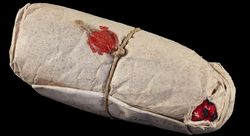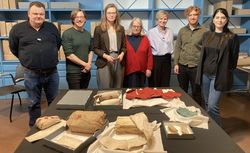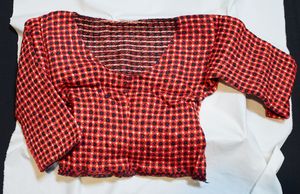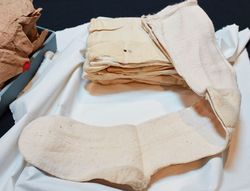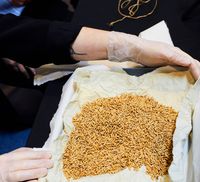Unpack and marvel
Unpack and marvel
Unpack and marvel
A 200-year-old knitted sweater from the Faroe Islands discovered in the Prize Papers Project of the German Academies’ Programme has made headlines around the world. Read on to find out how it happened and what other items the researchers from Oldenburg and London discovered when they opened four parcels for the first time.
When the Anne-Marie, a cargo ship sailing under the Danish flag, was captured by a British warship on 2 September 1807, it had been on its way back to Copenhagen from its annual trip to the Faroe Islands. On that same day the British Royal Navy began attacking the Danish capital after Denmark refused a request to support Britain against France in the Napoleonic Wars. The ship’s captain Jurgen S. Toxsvaerd and his crew, who had been at sea for several days, were unaware that as a vessel belonging to the Danish Crown the Anne-Marie was now considered an enemy ship by the Royal Navy, and its capture legal under the laws of war.
Its extensive cargo consisting of 49,000 pairs of woollen stockings, 8 tons of stockfish, 100 cases of candles, 250 barrels of tallow, 19 barrels of train oil and 10 barrels of feathers was confiscated by the captors and sold off at auction. The Danish Crown had a monopoly on all trade to and from the Faroe Islands at the time, and used two vessels which made two trips per year to the islands, so the seized cargo accounted for about a quarter of the annually traded goods. Business and private correspondence was also on board, but all written material was retained as potential evidence for a court case and never reached its addressees on the mainland.
Instead, it was stored together with other records, documents and pieces of evidence in the archives of the British High Court of Admiralty, which dealt with cases related to the seizure of ships in wartime. All these papers and items are now kept in The National Archives in London as part of the “Prize Papers” Collection. In the project of the same name led by Oldenburg historian Prof. Dr Dagmar Freist, researchers at the University of Oldenburg are working together with their partner in London, The National Archives, to sort through this vast collection, digitise the contents and make them available online in open access to academics and the public.
“There was something red poking out of the corner of one parcel”
More than two centuries after the Anne-Marie’s capture, Gustav Ängeby, a PhD student from Stockholm doing research in the Archives as part of “The Scandinavian Prize Papers” project, came across five sealed parcels among the stash of papers from the ship and brought them to the attention of the Prize Papers teams in London and Oldenburg. The experts quickly realised that this was a very special find.
The larger parcels were about the size of a one-litre bottle, their contents tightly wrapped in paper, tied up and sealed. “There was something red poking out of the corner of one parcel. Another made a rustling noise when shaken,” recalls Oldenburg historian Dr Lucas Haasis, Research Coordinator for the Prize Papers Project. The team quickly decided to involve researchers from the Faroe Islands in the opening of the parcels and contacted Professor Erling Isholm, a historian at the University of the Faroe Islands, and Margretha Nónklett, head of ethnology at the Faroes’ National Museum. The two Faroese academics travelled to London at end of February to meet members of the Prize Papers team and see the parcels being opened for the first time, almost 217 years after they were sent.
Unopened parcels with accompanying letters are a rarity
Most of the objects found among the Prize Papers to date have been quite small – things like signet rings, individual coffee beans and fabric samples. The five large parcels from the Anne-Marie – tied up with their accompanying letters – are “unopened an absolute rarity”, stresses project director Freist. The contents of the four parcels which were opened by Marina Casagrande, Prize Papers Project Conservator, each were different. “Each item is a very special find in its own right, especially together with the enclosed letters, which provide context and make precise classification possible", says Freist.
“There was a big ‘aha! effect’ each time a parcel was opened,” recalls Haasis, who represented the Oldenburg Prize Papers team at the unpacking. “We were all amazed and delighted to be part of this special moment. It’s impossible to suppress these emotions. The spirit of inquiry kicks in automatically.” The presence of the Faroese guests with their cultural and historical expertise was a big bonus, he adds.
The fifth parcel will remain sealed in order to preserve one of the five in its original state.
The finds
One item in particular caught the attention of the media – and not just in the Faroe Islands but also in the UK, Germany and even the US: a knitted sweater that closely resembles Faroese national dress in style and colours and was described by its sender, Niels C. Winther, as a “sweater for sleeping”. In a note dating back to 1807 which was enclosed with the sweater and addressed to a Mr P. Ladsen in Copenhagen, the Faroese carpenter Winther wrote in Danish: “My wife sends her regards, thank you for the pudding rice. She sends your fiancé this sweater and hopes that it is not displeasing to her.”
“This is a tremendously exciting find,” says expert Nónklett. “There are very few garments like this one, and we don't know of any with this particular design. It would have been handmade with hand-dyed wool.” The sweater is also the first garment of its kind that the researchers have been able to date with accuracy – precisely because it was in a parcel. Now they are focusing on the knitting technique and also analysing the material. They believe the light-coloured yarn could be silk, which was used to complement the wool. “When we first saw the parcel with something small and red poking out of one corner, we thought it contained a scarf," recalls Haasis. “A sweater, especially one with such a culturally and historically significant pattern, is a sensation – it’s invaluable for the cultural history and remembrance culture of the Faroe Islands," Dr Amanda Bevan from the London team explains.
One of the other parcels also contained knitted items: four pairs of women’s white knee-length woollen stockings which had barely yellowed over more than 200 years, thanks to the clever multi-layered packing technique. “Each pair of knee-length stockings was tied together with a woollen thread – just as you see today with socks that are sold in pairs,” Haasis notes.
However, in this case it was a private consignment – packed separately from the 49,000 pairs of men's woollen stockings that were also on board as merchandise intended for the Danish army. According to Professor Isholm, woollen products were the Faroe Islands' main export at the time – “the islands’ gold”, he observes.
Grain, on the other hand, had to be imported, and probably seldom made the journey from the archipelago to the mainland. The researchers were therefore surprised to find that one of the parcels contained barley samples, which were being returned to the original sender with a note complaining about the quality of an earlier shipment.
Out of 416 barrels of grain that had been sent, 399 had arrived damaged and 25 were in such bad condition that they couldn’t be sold, the writer of the note complained. “They wanted a retroactive price reduction, but because the proof of the inferiority of the goods never arrived due to the ship’s capture, it is unclear how the matter ended,” says Haasis, who explains that the Faroe Islands were dependent on Danish grain supplies to avoid starvation.
The Prize Papers team will now analyse individual barley kernels and, together with the Collection Care Department at the National Archives and possibly the Royal Botanic Gardens in Kew, London, attempt to germinate the seeds. This has already been achieved with the seeds of a special type of acacia which were found in the seized letters of a Dutch merchant and had been languishing in the archives since 1803 – four years longer than the barley from the Faroe Islands. The 200-year-old acacia seeds have grown into a handsome tree that can now be admired in the Royal Botanic Gardens in London.


